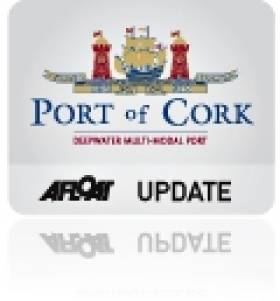Displaying items by tag: 3D Displays
Ringaskiddy Redevelopment Plans Go On 3D Display
#PortofCork – The Port of Cork Company today unveiled their proposed redevelopment plans for Ringaskiddy.
The proposed plans will be made available for public consultation later this week to display this key piece of strategic infrastructure which will be shown in 3D on a Real Simulated Model, highlighting the redevelopment from different aspects of the lower harbour.
The Port of Cork Company will hold three days of public consultation from 6th – 8th February to show the proposed plans for Ringaskiddy.
It is anticipated following this public consultation that the Port of Cork will lodge a planning application with An Bord Pleanala in April 2014.
The proposed developments under consideration form an extension to the existing facilities that Port of Cork currently operates at Ringaskiddy. Development is being considered in four key areas:
1. At Ringaskiddy East, where works will comprise of:
• A multi-purpose berth that will be capable of accommodating vessels carrying a range of different cargoes including containers, unaccompanied Roll On – Roll Off freight and general cargoes;
• An additional 200 metres long berth which will be used for port container traffic;
• A new container yard and marshalling area;
2. At Ringaskiddy West, where works will comprise of:
• A 180 metre extension to the existing Deepwater Berth;
• Dredging works to facilitate navigational access to the new facilities
3. At Paddy's Point, where a new public slipway is being constructed, new planting and landscaping is being provided in a new public amenity area and new pedestrian circulation routes, will be introduced.
4. Improvements to the existing road entrance at the Ringaskiddy Deep-water Terminal and internal road upgrades to improve connectivity to the remainder of the port complex and facilitate future connection to a new upgraded N28 both east and west of Ringaskiddy Village.
These proposed redevelopments are the first phase of the implementation of the Port of Cork's Strategic Development Plan Review (2010), the core principles of which were endorsed in the National Ports Policy, which highlighted Cork as a Tier 1 port of national significance.
The Policy also identified the continued commercial development of the Port of Cork Company as a key strategic objective.
As well as these proposed redevelopments, the Port of Cork is looking at a Demand Management System, which will allow the Port of Cork to control and manage the flow of unitised cargo, entering and exiting Ringaskiddy, at peak times, both in the short and longer term.
The Port of Cork is very encouraged by the NRA's recent commitment to the upgrade of the current N28 linking Ringaskiddy to Cork City. This vital piece of infrastructure will, when upgraded, improve the road network significantly.
Following the last round of non-statutory public consultation held in April 2013, the Port of Cork has taken into account, where possible, the comments from residents and communities within the harbour.
All feedback was considered and some amendments were made to the proposed plans presented at the time. The following elements were changed:
• Omission of reclamation and associated quay construction at Ringaskiddy West,
• The development area now includes the existing Ringaskiddy pier and slipway. A replacement pier, slipway and associated landscaped amenity area will now be provided at Paddy's Point.
• The upgrade of the existing road access has been changed from a roundabout to a signal controlled junction.
• Re-alignment of internal roads to tie in with the access point to the new N28
Speaking about the proposed redevelopments at Ringaskiddy Mr Denis Healy, Manager Engineering Services, Port of Cork said: "We have had constructive pre-application engagement with An Bord Pleanala to date and it is our intention to lodge a planning application in April this year. The 3D real simulation of the lower harbour, which will be on display during the public consultation, will help communities and residents to get a better picture of the redevelopment in Ringaskiddy from all aspects of the harbour."
"Our needs as a port of national significance have not changed. This European Policy positions the Port of Cork as a priority TEN-T Core Network port, the foundation blocks of which, will drive the Port to meet future connectivity needs and will support the development of the wider regional and national economy. This TEN-T funding is of key importance to the port."
Mr Healy outlined the specific drivers for this port redevelopment as;
• A Tier 1 Port of national significance which must continue the commercial development of the Port of Cork Company as a key strategic objective
• Current Navigational and Landside Constraints at Tivoli Container Terminal
• Need to Develop a New Deep-water Container Terminal capable of efficiently servicing Larger and Deeper Drafted Vessels
• Overcome Berthing and Landside Capacity Constraints at Ringaskiddy Deep-water Terminal
• Provide Certainty for all Stakeholders that Consolidated Replacement Facilities can be provided.
• Maximise the Utilisation of Existing Port Assets and Locations
• Need for Port to respond to changing Trade and Logistics Dynamics
• Flexibility to Respond to Needs as they arise in a Financially Sustainable Manner
The Port of Cork is a key link to the economic success of Ireland, in particular the entire Munster region. 98% of goods imported or exported from Ireland are moved by ship, highlighting the importance of ports to our economy.
Dates and venues for the public consultation will take place as follows:
• Thursday 6th February 2014 3-8pm – Sirius Arts Centre, Cobh
• Friday 7th February 2014 3-8pm – National Maritime College of Ireland (NMCI), Ringaskiddy
• Saturday 8th February 2014 10am – 2pm - National Maritime College of Ireland (NMCI), Ringaskiddy
Further information can be found on www.portofcork.ie





























































